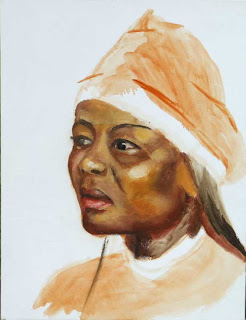By the time Watteau died at the age of thirty seven he and his work were famous and well respected. Some magnificent memorials were erected to his memory
.
![]() |
| Carpeaux monument to Watteau |
So what happened to his wonderful paintings that had inspired France to celebrate him on such a grand scale but are now thought of as dull lifeless things?
This is what Brian Sewell had to say of them in
a recent review.
"The Wallace Collection's own paintings by Watteau (or associated with him) have been gathered in the upstairs room.... They look grubby and neglected things of smudge and fudge, both overcleaned and undercleaned, victims of cleaners with Brillo pads and restorers with a taste for gravy. Watteau at the Wallace Collection, as this second half of the exhibition there is called, is a sorry sight.
It is dominated by a Fête Galante almost two metres wide, given the date c.1719-21. The general tone is dark, the time of day suggested early evening, the sun already set, but the many figures are patchily lit from unseen sources entirely contrary to the shadows of the dying distant day, so that they seem added to the landscape rather than organically part of it - some even float as though levitating. To the right, the trees conveniently parting to reveal a patch of too-blue sky, against it is a statue of a woman in the artificial lighting of the stage, her gross and rather modern nakedness unseemly in this elegant company. Relined in the mid-19th century - then usually a disastrous procedure with hot irons and animal-based glue - and haphazardly cleaned in 1976, this painting is a mess....
A Lady at her Toilet, a calculatedly erotic little picture that should sparkle with provocation in every touch of the caressing brush, has a lifeless surface that is both scraped with overcleaning and ingrained with ancient dirt."
---------------
Edit 09-09-11 More info on
The Controversial Treatments of the Wallace Collection Watteaus at ArtWatch UK
---------------
This reminds me of a passage in Harold Speeds book
"Oil Painting Techniques and Materials" first published in 1924 in which he talks enthusiastically about Valasquez’s painting of Philip IV.
But by 1949 he had to add the following preface:-
"VELASQUEZ' PORTRAIT OF PHILIP IV IN 1949
Alas ! The thin final painting, with its warm scumbles and pearly films of paint, that I have been trying to describe, and which was so delightful, alas ! it is no more.
Science is now the unquestioned authority ; and our National Gallery is in the hands of learned men, with the best intentions and wonderful scientific instruments to do their perceptions. Apparently they are allowed to do whatever they like with the nation's pictures.
The subtle things I have been trying to describe are, however, outside the perceptions of scientific instruments, or scientific minds ; and have not, unfortunately, survived their treatment.
By all means get the dirt off the pictures ; but stop before any of the original varnish is reached. Subtle filmy finishings and glazes become incorporated with the varnish and come away with it ; as, alas ! has happened in this case.
Look carefully at these two reproductions under a
magnifying glass, and notice what has been removed. Look at the size of the iris of the eye, how much larger it was before the finishing film of paint was removed with the varnish in the drastic process of cleaning it has undergone. See its upper edge against the eyelid, how much firmer it was drawn by Velasquez in the final refining. Notice the mark of one of the outer hairs of his long-haired brush, how it has strayed over the dark of the eye in one place. Then notice particularly how in the last painting, this looseness on the edge has been painted over, in enlarging and refining the shape of the iris. Since the recent cleaning,-this loose light touch over the dark eye, has come to light again ; the last painting, which has covered it for 30o years, having been removed. A proof, for all the world to see, that the final film of paint has been removed in the cleaning.
Another finishing touch that has come away, is the more refined shape of the tone forming the under eyelid. Instead of being the jagged edge it now appears, it had the more definite shape that can be seen in the photograph taken before the cleaning. If you measure it from the top right-hand corner of the iris against the eyelid, you will find it was wider than it is at present, the left-hand edge of the under eyelid having been more to the left.
What is here illustrated in detail, has, I fear, happened over the whole head ; and what is now left, I can no longer call " one of the last and most beautiful things Velasquez ever painted.""
This illustration is from the 1987 edition and although not very clear gives some idea of what has upset Speed so much.
And the same after restoration in colour.
Unfortunately these are not isolated incidences and restorers seem not to have learnt from outraged artists and critics.
Thankfully the restorers have not got hold of Watteau’s drawings.








